Extending timber harvest rotations is on the table as a triple bottom line solution—actually a sextuple bottom line solution. But is it really a good idea, and is it even possible? If so, how do we do it?
In my last article, I posed the question: do long rotations really boost carbon storage and produce more timber? The answer is a resounding “Yes.” This article investigates why today’s forest landowners log on short rotations and what stands in the way of extending rotations. In a future article, I will examine how, through careful planning and public investment, we can overcome these hurdles and transform Cascadia’s forest landscape to long rotations in a way that works for timber-dependent communities.
Brief review: The six bottom-line benefits of harvesting timber on longer rotations
(For an extended definition and discussion of long rotations, see my prior article. But here’s a brief review before we dig in on their challenges.)
A “forest rotation” is the number of years that a crop of trees is grown before the forest is logged and replanted.1 Long rotations mean growing trees longer before logging.
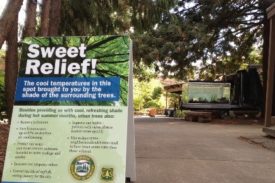
Source: Oregon Dept of Forestry
In the past, timberland owners cut their trees at a “biological rotation age.” A biological rotation age maximizes the amount of timber that the land can sustainably produce per year over time.2 For instance, the biological rotation age for Douglas-fir west of the Cascades might be 80–100 years. Today, most timber companies log their forests at a much shorter “financial rotation age,” often less than half the biological rotation age. By doing so, they maximize short-term profits at the expense of long-term timber volume, forest health, and carbon sequestration.
Why are long rotations a sextuple bottom line solution? First, they have garnered the most attention for being the best “natural carbon solution” for California, Oregon, and Washington (that’s solution #1 of 6). Modelers also show that long rotations produce more total timber as well as higher quality and more valuable lumber for building homes (that’s #2).
And, at a time when Washington and Oregon are scrambling to plan for wildfires (and pay for them), it turns out that long rotations likely mitigate fire severity (#3). Long rotations also improve water quantity and quality and serve as habitat for rare wildlife (#4 and #5). Finally, if history is a guide, extending rotations could help return stability to timber markets and flourishing economies to rural timber communities, if we can get past a transitional supply dip (and that’s #6).
If long rotations are so much better, why aren’t they more common?
#1. The time value of money
As mills sold off timberlands starting in the 1980s, the new owners changed from long rotations that maximize a steady supply of timber for the mill to management that maximizes their return on timberland investments (ROI).3 This is especially true for investor-owned Real Estate Investment Trusts (REITs)4 and Timberland Investment Management Organizations (TIMOs),5 6 which currently own a majority of private US timberlands. Large, family-owned timber companies also need short-term profits, especially if they want to invest in complementary businesses or grow their landholdings. It’s more lucrative to log short rotations on more land than long rotations on less land.
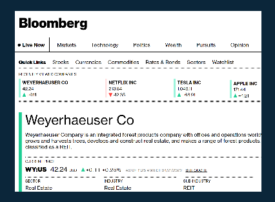
Weyerhaeuser, Tesla, and Apple stock on April 21, 2022 (Source: Bloomberg Quick Links).
TIMOs and REITs have raked in windfall profits. From 1990 through 2007, TIMOs averaged a whopping 13 percent return on investment,7 exceeding the 11 percent averaged by the S&P 500 over the same period, with far less volatility (i.e., making them less risky).
When forestland is held as a financial investment, it must appreciate as fast as Apple or Tesla stock, or other competing investments. Investors want compounding growth,8 which means that value increases exponentially over time.

Tesla charging station (Source: Piqsels).
The opportunity cost of not cashing in the trees now and investing in lucrative land deals or Tesla stock means that income received in the future from long rotations is essentially worth less than the same income received today. This is why selling a smaller volume of timber today can be worth a lot more than selling a bigger volume in the future. To find out how much a future timber sale is worth in today’s dollars (called net present value, or NPV), companies reduce future income by a discount rate9 equal to the rate of return that they can expect on alternative investments.
The value of a forest grows as the trees mature. Through a forest’s adolescence, trees grow faster than the rate of return on Tesla stock—so they’re still increasing in today’s dollars, as calculated with a discount rate equal to the rate of return on Tesla stock, for example.
Eventually, two things happen. First (and most importantly), because of the compounding rate of return, the Tesla investment grows by more and more each year, soon outpacing tree growth. Second, the trees’ annual growth begins to slow down. The forest continues strong average annual growth, but it is not accelerating as it did in its youth.
Companies calculate when to harvest—the financial rotation age—based on a discount rate they set at their needed rate of return. They harvest at the age that maximizes the value of the future timber harvest discounted into today’s dollars.
In the figure below, the gold bars indicate the financial rotation ages that result from using a 4 percent discount rate (which roughly corresponds with some states’ forest management) or a 7 percent discount rate (closer to TIMO or REIT management).
You can see how small changes in the chosen discount rate cause big changes in the age when forests are logged. Compared with the biological rotation age (the green bar in the figure), discounting future harvest income, even with a low 4 percent discount rate, slashes the rotation age by 35 years. Using a 7 percent discount rate shrinks rotation age by 50 years (see the methods section below for more details).
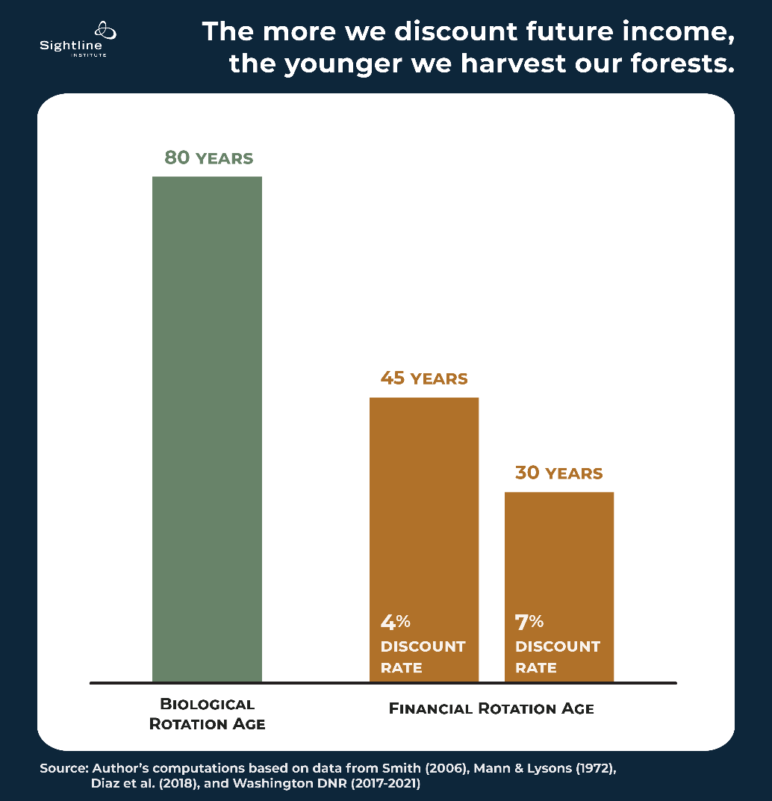
Biological rotation age versus financial rotation age for a Douglas-fir forest west of the Cascades. Numbers will vary for different forests and market conditions.
Getting their money upfront means more profits for timber companies and investors, but less value for everyone else. One long 80-year rotation yields more lumber than two short 40-year rotations, as well as more carbon savings, a better home for the many species that prefer old forests, and more cool and clean water. These are the opportunity costs of short-rotation forestry.
“Getting their money upfront means more profits for timber companies and investors, but less value for everyone else.”

Rotation length is one of many ethical controversies stemming from the discounting of future values and ecological benefits, from habitat to mitigating climate change.10 But don’t despair! In my next article, I will discuss ways to bridge the gap between financial and biological rotation ages and incentivize landowners to grow older forests.
#2. Mills and engineered wood
A second, related hurdle for long rotations is a lack of mills tooled to process the large-diameter logs from older trees. Most mills today do not accept large logs (i.e., over 20 to 28 inches in diameter), and if they do, they typically discount them 10 to 30 percent because they are more labor-intensive to cut.
For Richard Pine, who owns timberlands in the southwest corner of Washington, there is not one mill within economical trucking distance set up for his large logs. Pine said, “Because our trees are too big, even at 65, for mills in this area, we long-butt them: we leave 10–15 feet on the bottom, and then start cutting our logs above that. Or we’re selling them as cheap wood for firewood and pulp.”
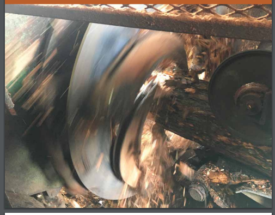
The narrow opening of a mill’s small-diameter “ring debarker” is just one part that limits log size (Source: Eric Simmons, US Forest Service).
Since the 1980s, the mill infrastructure has shrunk in number from many small-capacity mills tooled for large logs, scattered across the landscape, to a much smaller pool of high-capacity mills that are extremely efficient and highly specialized for small logs (i.e., 7 to 11 inches in diameter).
In the past, mills paid a premium for large logs. Older trees mean wider and longer boards that can serve a greater range of purposes. The denser and stiffer wood makes stronger lumber and, if managed well, contains more premium knot-free and straight-grained “clear wood.” Large logs also mean more lumber out per volume in (i.e., less wasted wood) as round logs are sawed into rectangular boards. On average, the value of older trees is up to 55 percent higher per board foot compared with younger trees. But today, this value typically doesn’t translate into log price.
Older trees still produce superior wood, so why don’t mills want them anymore? The answer lies in a perfect storm of insufficient large-log supply, corporate restructuring, mill automation, and engineered wood product technology. (But, ultimately, the main culprit is the financial rotation age.)
When old-growth forest was plentiful in the US West, the timber sector hummed along processing large old-growth logs and large logs from long rotations. Gradually, the old growth was used up, and, as an outcome of tremendous conflict, in 1994, the Northwest Forest Plan drastically restricted logging in the remaining supply to protect the northern spotted owl. In response, private lands increased their harvest rate and logged on shorter rotations.
The contraction in large-log supply coincided with breakneck corporate restructuring, consolidation, and automation across the entire US economy during the 1980s and 1990s. Mergers and acquisitions in the wood products sector—just like the retail grocery market, airlines, and almost every other sector—aligned CEO compensation with shareholder return on investment. This forced companies to focus on short-term profits and high efficiency. Fewer but larger mills, located near highways or railroads, yield higher profits than scattered smaller mills. Smaller and more uniform logs jibe with the automation of mills, which lowers labor costs (by up to two-thirds) and propels profits.

A construction crew installs a cross-laminated timber panel (Source: Marcus Kauffman, Oregon Dept. of Forestry).
Around the same time, the rise of engineered wood product technology decoupled the construction sector from its reliance on large lumber. According to Dr. Kent Wheiler, who directs the Center for International Trade in Forest Products (CINTRAFOR), “What used to be a solid piece of lumber, now it’s an I-joist, glulam, OSB, or CLT.” Oriented strand board (OSB), cross-laminated timber (CLT), and these other products are made by gluing together sawdust, wood fiber, chips, or small-dimension lumber. Today, the construction sector has fully integrated the new technologies. People know how to use them, and building practices have adapted. Now that these alternatives are available, builders won’t necessarily pay a premium price for solid wood to replace an I-joist that will be hidden from view behind drywall.
Port Blakely, a timber company known for its long rotations, witnessed its large-log premium go from standard, to niche market, to practically nil, as engineered product proliferated. Back in 1996, when Port Blakely’s large-log market was booming, it negotiated a 50-year habitat conservation plan (HCP) as insurance in case its long rotation habitat invited in the spotted owl. Part of the deal was maintaining the company’s 60-year rotations. (More on HCPs below.)
Twenty-five years later, despite their efforts at creating flight corridors, understory canopy, and habitat for flying squirrels and other owl prey, the spotted owl still hasn’t moved in. But Port Blakely’s Asian large-log market has evaporated. According to Mike Warjone, President of its US forestry operations, without this market, the 60-year rotations required by its HCP cost the company somewhere in the realm of 7–8 percent in revenues on those stands. Plus, it’s now forced to manage for high density (and thus lower quality habitat) in order to grow skinny 60-year old trees to fit into small-log mills.
Is competition from engineered wood responsible for today’s short-rotation forestry? Or is engineered wood the market’s response to a chronic shortage of large logs? According to Dr. Wheiler, “There’s always a market [for large logs]. It’s the mills; that is the question.”
But are the mills really the bottleneck? Nathan Nystrom of Hull-Oakes says, “Yes and no. In the 1990s, when they started cutting smaller trees, the mills re-tooled. If larger trees will start coming out of forests, mills can re-tool again.”
One forest owner, even a large one like Pork Blakely, cannot revive a large-log mill infrastructure. It’s a tough chicken-and-egg problem to solve. But it seems that ultimately the decisive factor limiting mill demand for large logs is the financial rotation age. Wheiler sums it up: “Markets respond to the resource that’s available.” If larger logs were abundant, would is still be cheaper to create a glulam beam? If there was a reliable supply of large logs, then mills, engineered wood technology, and construction practices would adapt.
“Reinventing large-log manufacturing and a dispersed mill infrastructure, sited closer to forests, could offer more economic opportunities for otherwise isolated woodland owners and communities and would lower the financial and carbon costs of trucking logs to faraway mills. Our mill infrastructure has 40 years to make the transition.”
It’s crucial that the transition back to larger-diameter logs be less devastating and divisive than the upheaval of the 1990s. If done well, it could reverse job loss and revitalize timber-dependent communities. Reinventing large-log manufacturing and a dispersed mill infrastructure, sited closer to forests, could offer more economic opportunities for otherwise isolated woodland owners and communities and would lower the financial and carbon costs of trucking logs to faraway mills. Our mill infrastructure has 40 years to make the transition. At current profit margins, that is plenty of time for today’s mills to recover their capital investments and plan for the future.
#3. The Endangered Species Act: Fear of the spotted owl
Perversely, another obstacle to long rotations is the Endangered Species Act (ESA).
A century of intense logging of Pacific Northwest old-growth forests threatened extinction for the spotted owl, marbled murrelet, and other species dependent on old-growth habitat. Now, the Endangered Species Act (ESA) prohibits the “take” of these species, including harassing or harming them, or destroying habitat needed for breeding, feeding, or sheltering.
Especially when managed for habitat, long rotations can support certain aspects of old-growth habitat, such as large trees, rich food webs (including lichen, insects, rodents, and flying squirrels), high canopy layers, standing dead trees (called snags), and open spaces for flying underneath and between trees.

A spotted owl swoops down to catch a mouse (source: Emily Brouwer, National Park Service).
Many forest managers worry that extending their harvest rotation might welcome in an endangered species, triggering ESA protections that prevent logging. Richard Pine told me, “We don’t want to invite the spotted owl in… We want to do our part for the environment, but also to make sure we have trees that are harvestable.” In one area of Washington, for example, if a spotted owl nest is found on private land, state regulations prohibit logging on 70 acres around the nest.
According to Mark Rasmussen, a forest economist and principal at Mason, Bruce & Girard, it is standard industry practice for landowners, as company policy, to never let their forests get old enough to become suitable habitat. If a landowner does want to grow older and larger trees, they might avoid creating habitat by isolating the older stands from Forest Service land or other protected habitat and by either planting too densely for animals to thrive or spreading the trees far apart from each other.
An increasingly common way to manage these perverse incentives is for landowners to negotiate a deal with federal agencies to get a degree of immunity from ESA liability. Under a Habitat Conservation Plan (HCP) or Safe Harbor Agreement, landowners agree to specific habitat-promoting forest management practices—such as riparian buffers for salmon or minimum 65-year rotations and flight corridors for spotted owls—in exchange for an “incidental take permit” that allows unintentional but not unexpected harm to some habitat or some individuals.
One problem is that HCPs are expensive. According to Warjone, negotiating an HCP similar to the one it recently negotiated on 30,000 acres in Oregon could cost a landowner over $1 million. Port Blakely’s land holdings are large enough to make this a reasonable cost of business. But small forest landowners, who tend to value provision of wildlife habitat and environmental benefits above production of timber products, typically cannot afford HCPs. ESA administration has and must continue to adapt.
It’s unclear just how much risk the ESA poses to private landowners. Under industrial timber management, it’s rare for a spotted owl to move into a private forest; they are listed as threatened for a reason. But that could change with long rotations.
#4. The supply paradox: How do we get back to long rotations?
A huge challenge in extending rotations is how to bridge the supply gap during the transition. The irony is that longer rotations produce more timber per year. But today’s timber industry is trapped in a short rotation equilibrium, where extending rotations could jeopardize near-term profits, jobs, and supply.
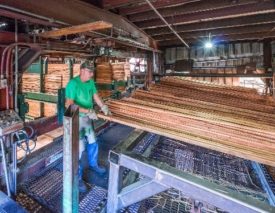
Malheur Lumber in John Day, OR (Source: Marcus Kauffman, OR Dept. of Forestry).
“Before, you could just see how it would all work,” explained Edie Dooley, a forester with Mason, Bruce & Girard. “Long rotations kept the mills supplied.” But when harvest increased on private lands and rotation age decreased, “it derailed the whole thing,” Dooley said. “Now, how do we get back there? That is the big struggle. It will take a while. We need to do it incrementally and spread it over geography. Otherwise, you’re just going to kill your industry, communities will suffer and all the logging firms, and we’re not producing renewable resources.”
Court Stanley, former president at Port Blakely, said, “Once a company decides to reduce the rotation age, it’s almost impossible to go back up. Because you have to stop cutting, and cash flow stops. It’s possible, but revenues would drop dramatically.”
Climate change only makes the supply challenge worse. Today, floods, mudslides, fires, drought, and pests are voraciously eating into timber supply. Long rotations extend the period that timber is exposed to these risks. However, another irony is that older forests experience lower fire severity compared with younger, intensively managed forests, even during extreme weather conditions.
Growing out of short rotations
Off the record, an Oregon forester confided, “I’ve flown all over the state, a lot. I tell you, the footprint of bare ground in the Oregon Coast Range is astronomical. It’s just not sustainable. We need to figure out some way to keep the trees on the landscape longer. At this point, we’re growing corn.”
Longer rotation forests are more functional forests, both economically and ecologically. They nurture the land’s capacity to grow timber, a high and stable supply of quality logs, reliable timber jobs, and a plethora of ecosystem services. But with so many challenges, it feels like the timber industry is trapped.
Is there a way out? Perhaps. Efforts are already underway to unlock this short rotation equilibrium. Ecological investment strategies could reduce management costs and capture alternative revenues. Public support could buoy a decentralized infrastructure of versatile mills, and research on where to site large-diameter mills has already begun. An “all lands” approach, including a gradual patchwork strategy on specific parcels, could bridge the supply gap.
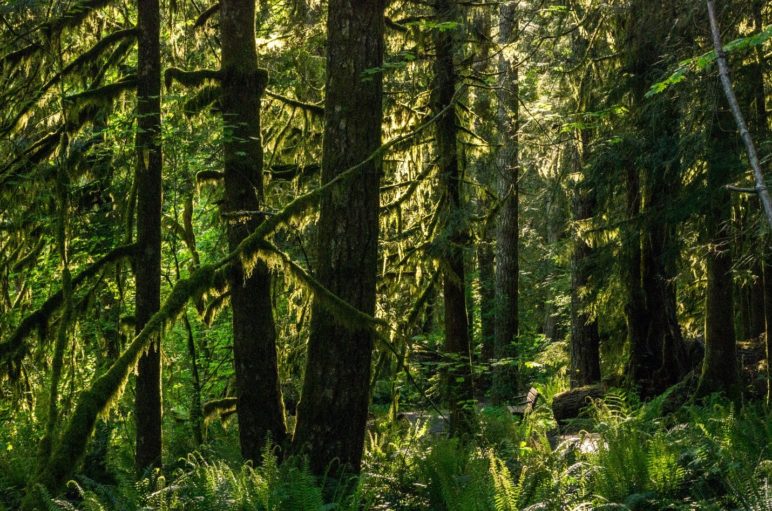
Clackamas County, OR (Source: David Prasad).
Methods
For the bar graph, to calculate how the discount rate changes rotation age, I first estimated the net present value (NPV) function of future timber harvests using the discount rates of 4 percent and 7 percent. Next, for each discount rate, I found the rotation age that maximizes net present value.
I chose the discount rates to illustrate a realistic spread: 4 percent is an approximation for state forest management (although many state agencies realize that sustained cash flow over time is more useful than targeting a specified rate of return); 7 percent is an approximation for TIMOs and REITs and likely a ceiling for private forests. In reality, different companies choose their specific discount rate based on their particular goals, opportunities, and market conditions. In the recent past, TIMOs have used discount rates as high as 13 percent, but they are typically lower. Federal forests are not managed for ROI, and the goals of small woodland owners are too diverse to capture with a discount rate exercise.

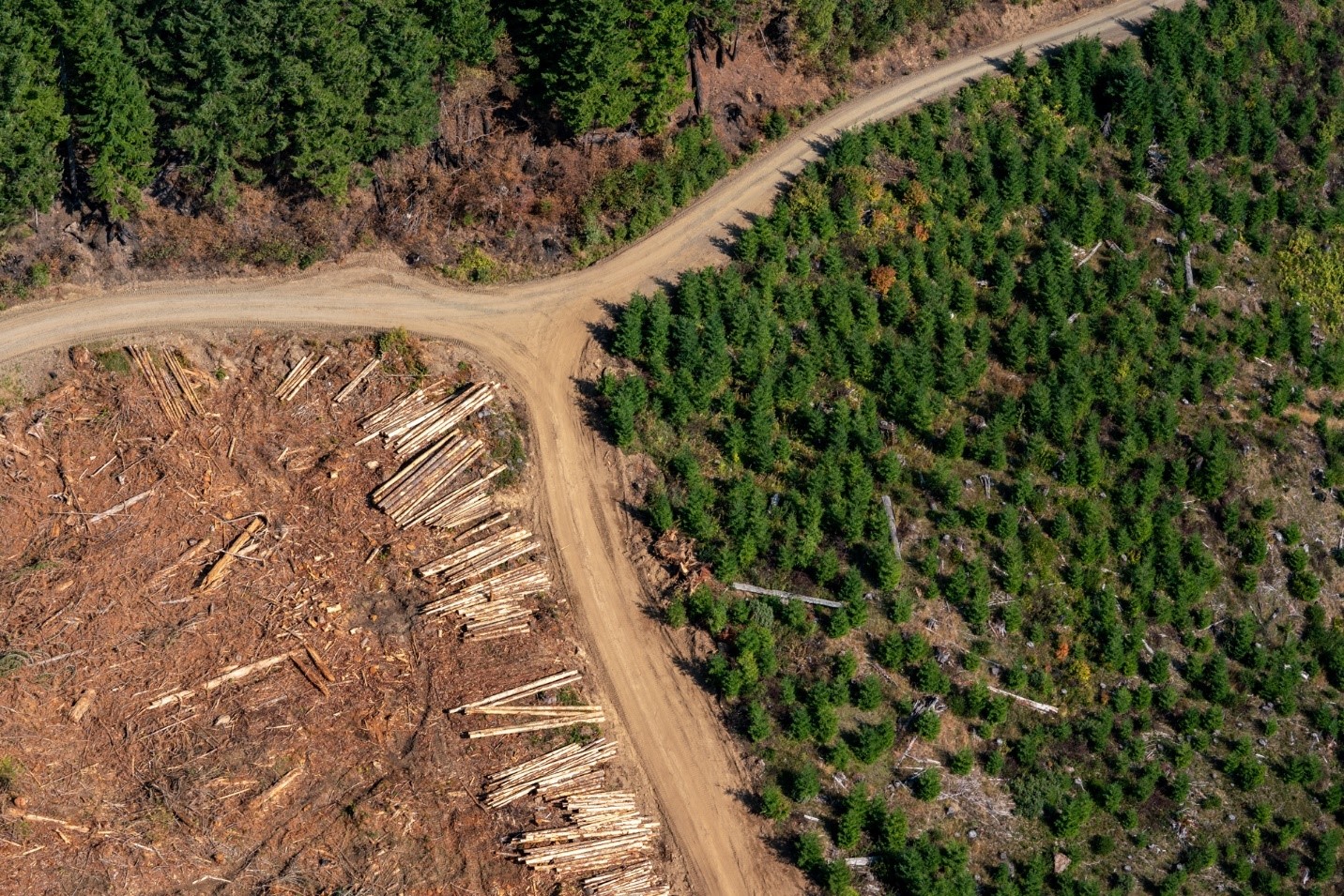
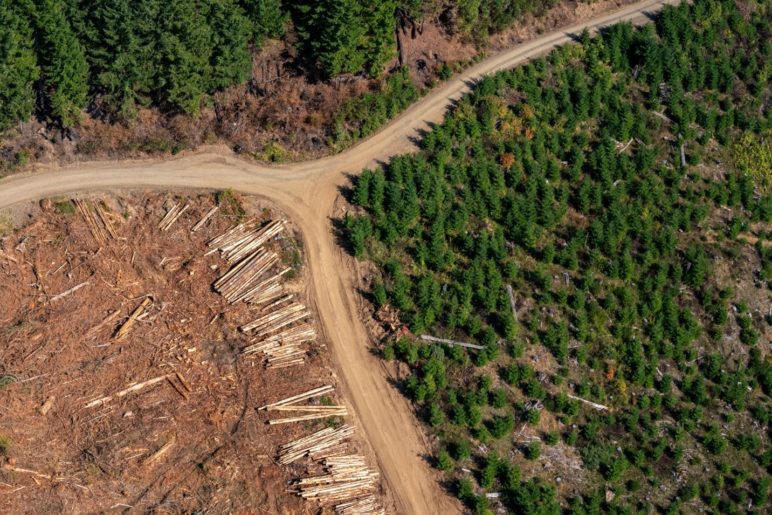




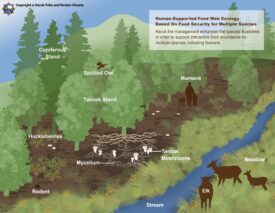
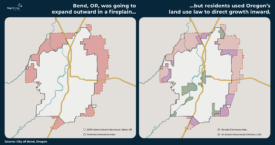



Steve Erickson
First, the 1994 Northwest Forest Plan was not only to protect the northern spotted owl. It was a first in that it was intended to protect mature and ancient forest ecosystems.
Second, none of this is new. People have been pointing out the inherent problem of forest management driven by the siloed economics of PNV (Present Net Value) and ROI (Return on Investment) since at least the 1980s. The reality is that trees are never going to generate the return possible from investing in Tesla et al., or even just selling the land for McMansions and Chateaus on the Hill. Barring a wholesale (pun intended) change in western economies to an ecological as opposed to a siloed economic basis, I doubt that’s going to change.
Humans have simply created a system that they are now imbedded in that will use up their life support system even as they are too busy to notice because they simply cannot imagine the fundamental changes necessary for survival.
Pessimistic, but there you go.
Thornton Moore
I really enjoyed. Reading your article on forestry sustainable and carbon input of longer rotation harvesting methods our future depends on the ecosystem substantially .
Dale
>Is there a way out? Perhaps. Efforts are already underway to unlock this short rotation equilibrium. Ecological investment strategies could reduce management costs and capture alternative revenues. Public support could buoy a decentralized infrastructure of versatile mills, and research on where to site large-diameter mills has already begun. An “all lands” approach, including a gradual patchwork strategy on specific parcels, could bridge the supply gap.
So much for the solutions promised in the first article in this series. “Alternative revenues” is easy to say, and as every public land manager will tell you, very difficult to realize. I suppose the public could funnel cash toward manufacturers, but that only takes care of the owners. It doesn’t keep people in mill towns employed. Either the logs are there, or they aren’t. As for the “all lands” approach, excuse me if I remain skeptical of increased federal land supply — promised over and over and over since the NWFP first went into effect (a billion board feet!). All of those promises turned out to be . . . let’s just say wrong.
Again, it’s not a question of whether extended rotations take a bite out of the industry. It’s only a question of how big a bite, and for how long.
As an aside, it’s amusing to some of us that the very same institutional investors that got us into this mess by aggressively reducing harvest rotations are the same ones now trying to convince the public they should be paid to extend rotations again.